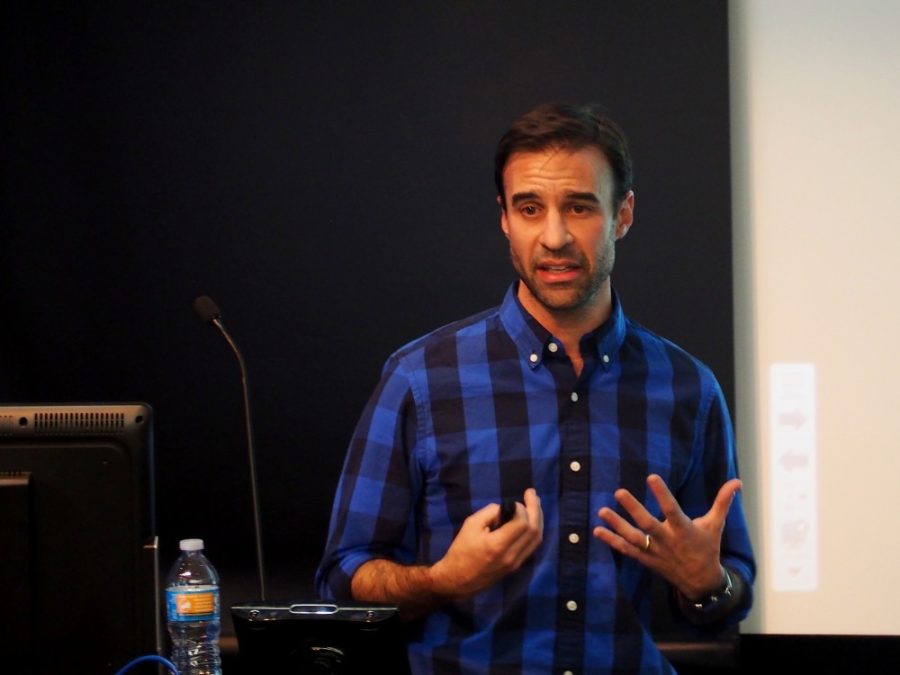David Raichlen, an associate professor in the School of Anthropology at the UA, gave a lecture on Tuesday, Nov. 8, about his recent findings on human activity and inactivity, and what they could mean about our evolution and anatomy.
As the famous evolutionary biologist Theodosius Dobzhansky put it, “Nothing in biology makes sense except in the light of evolution.” This is the mantra that inspired Raichlen to take an evolutionary perspective on a physiological issue.
“Two and a half million years ago, the earth began to cool down, so there were fewer forests and more grasslands,” Raichlen said. “Hunting and gathering likely led to increased activity. … Physical activity and inactivity shaped aspects of human physiology.”
RELATED: UA biologist investigates origins, spread of HIV
Later, fossil evidence shows that our hunter-gatherer ancestors were much taller and had larger joint surface area than their largely sedentary predecessors.
Anthropologists believe these taller humanoids used a technique called persistence hunting, essentially running or walking prey into heat exhaustion. And Raichlen supports that theory.
In order to put this hypothesis to the test, Raichlen, along with a group of anthropologists, went to Northern Tanzania to study the Hadza people, a tribe surviving almost entirely on hunting and gathering. They are believed to live a similar lifestyle to our grassland ancestors. Raichlen and his team used a variety of methods including heart monitors, motion detectors and blood pressure to measure the frequency of activity and inactivity in the Hadza.
Blood pressure data suggested the Hadza people don’t experience an increase in blood pressure one would see in the urban population with aging. This in itself is quite the discovery. As Raichlen puts it, “Hypertension and cardiometabolic risk are not an inevitable part of aging.”
The most interesting data from the heart rate monitors and motion detectors shows that while the Hadza’s lifestyle has allowed them to escape the health risks that come with aging, they are just about as active and inactive as the average urban individual.
Excluding sleep, the Hadza were active for about three hours and inactive for nearly nine hours during a day, which is on par with the urban human, according to Raichlen. Based on the team’s findings, Raichlen concluded that our hunter-gatherer ancestors’ lifestyle as well as our evolutionary biology, “likely included high levels of physical activity, but not necessarily high-energy expenditures.”
According to Raichlen, the question remains: What does the Hadza do differently that allows them to display a lack of inactivity-related illness?
Raichlen theorizes it could possibly be as simple as a result of the way the Hadzas sit that makes the difference.
“It is a very recent thing that we sit in chairs designed for complete muscle inactivity,” Raichlen said.
RELATED: Evidence of new dinosaurs found in Idaho
The Hadza people spend just as much time being inactive as we do, but it is rare that they do so in a chair similar to those so common in the urban world, Raichlen said. In fact, they often squat or sit on the ground. Muscle activity readings taken by Raichlen show the Hadza partake in “active rest.” In other words, their muscles are still working even when they are in a state of inactivity.
“It seems clear that exercising the recommended amount is not enough to escape the adverse health effects caused by sitting,” Raichlen said.
How does an urban individual apply this research in their life? Raichlen suggests investing in a standing desk or something comparable to avoid the independent health risk that sitting has on our bodies.
Perhaps the most practical thing to be done, though, is to get up and walk around every once every so often. The American Heart Association recently reported that along with 150 minutes of exercise a week, it recommends getting up from a sitting position about once every 30 minutes.
Whether Arizonans immediately embrace these lifestyle changes or not, the work done by Raichlen and other researchers is shedding light on potentially deadly habits and in doing so helps make us more conscious of our daily lifestyle choices.
Follow Chandler Donald on Twitter.









